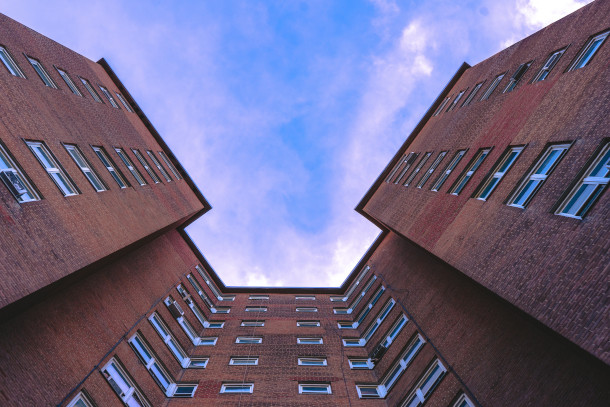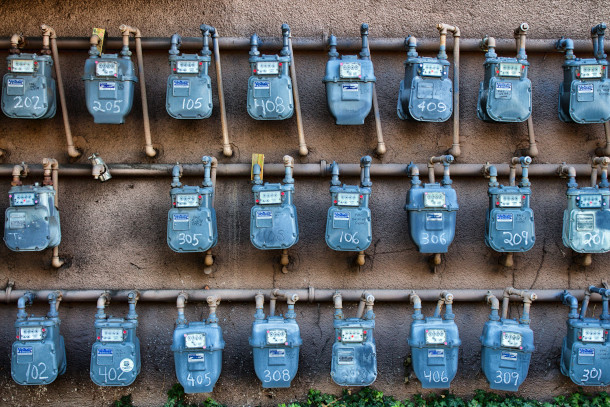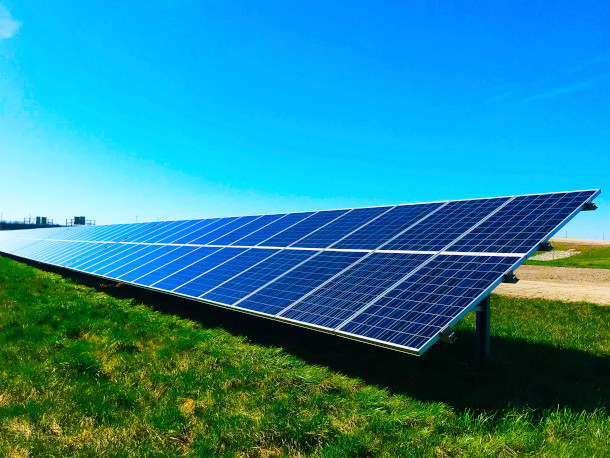Renters and Climate Change
Air Date: Week of September 9, 2022

Rental properties, like apartment buildings and the NY government housing complex pictured above, comprise more than a third of U.S. housing stock. 40% of the U.S.’s rental housing stock faces risk of damage from climate disasters, according to Harvard University’s Joint Center for Housing Studies. (Photo: Avi Werde on Unsplash)
As climate change brings higher temperatures and extreme weather to American cities, our rental and affordable housing stock remains largely under-equipped to deal with these new challenges. Todd Nedwick of the National Housing Trust joins Living on Earth’s Jenni Doering to discuss what renters and landlords can do to fortify homes against a changing climate while transitioning to cleaner energy.
Transcript
CURWOOD: Thanks to the Inflation Reduction Act that President Biden signed on August 16th there will soon be funds and programs for homeowners to take climate action by installing solar panels and energy efficient heat pumps. But renters typically use a third more energy per square foot than homeowners because landlords often don’t get a financial return on installing expensive upgrades to improve insulation and HVAC efficiency. And many renters are low income people who can ill afford higher energy costs. But there are ways for people living in rental housing to go greener, save energy costs and guard against heat waves and other climate related risks, says Todd Nedwick the Senior Director of Sustainability Policy at the National Housing Trust. He spoke with Living on Earth’s Jenni Doering.
DOERING: So we want everyone to be able to play a role in mitigating the climate crisis. A landlord, they don't always have that clear incentive to do so. So what kinds of carrots, or sticks for that matter, can help prod building owners to reduce their energy consumption?
NEDWICK: Sure, well, in terms of carrots, there are incentive programs out there, utility energy efficiency programs, for example, that will help to offset the cost of making building upgrades. Those are really important resources for building owners, especially owners of affordable housing, where there really is very limited cash flow to actually pay for the upfront cost of some of these upgrades. And we're also seeing policies like building energy performance standards, which basically require building owners of poor performing buildings to make upgrades to reduce energy use of the buildings. So we are seeing both carrots and sticks. I think what works most effectively is when you combine the two. So, if you're going to have a building energy performance standard and require building owners to make upgrades, especially in affordable housing, providing resources to the owner to actually pay for some of those costs is pretty important.
DOERING: And how do those incentives and standards work? Are they at the local level, the state level, the federal level?
NEDWICK: Yeah, so the standards are typically at the local or state level. And you know, building energy performance standards is a pretty new policy. There are several cities that have implemented building performance standards, and Maryland just became the third state that adopted a building performance standard statewide. And then for the incentive programs, typically those programs are at the utility level. So it's utilities that are providing those incentives to their customers. However, state public service commissions really make decisions that impact the utilities' motivation to provide those energy efficiency programs. Input from residents, from affordable housing providers, is really key to designing these programs in a way that's truly equitable, and achieves healthier, more energy efficient housing for everyone.
DOERING: So the good news is, even though it is a little bit harder for renters to make some of these changes, there are still things that renters can do. So if you're not a buyer, what are some of those sustainable changes that you can make to your residence?

Studies show that American renters use one third more energy per square foot than homeowners, generally due to poor insulation and outdated appliances. This can cause low-income renters to pay as much as 20% of their income in energy costs. (Photo: Jason Richard on Unsplash)
NEDWICK: Now, one opportunity for renters is community solar. We know that renters can't control the installation of solar panels on their building, but they can access community solar, which allows residents to basically purchase solar generation from a solar community. Renters can have control over, for example, improving the lighting in their unit, using more efficient lighting like LED, as well as talk to their landlord and encourage their landlord to participate in some of these energy efficiency incentive programs. It's unjust that for so many people, they're paying 10, 20% of their income on energy costs, it just leaves very little money for other essential needs.
DOERING: A lot of sustainable changes like weatherization, even some energy efficiency measures, may come with a significant upfront price tag. What resources are available to help landlords make these upgrades?
NEDWICK: Sure, so many utilities offer energy efficiency rebate programs, which helps to defray some of the costs of the building upgrades. There's also financing that can be available, a lot of green banks develop targeted financing programs for affordable housing, which provides the upfront resources that building owners will need to make those building upgrades. In terms of affordable housing, what we see is somewhere in the range of subsidizing 60 to 80% of the building upgrade costs.
DOERING: So, Todd, when my old landlord decided to put in a nice cedar closet upstairs, my roommates and I got a little worried about him using that to justify raising our rent. What provisions are in place to make sure this doesn't happen when, you know, a landlord installs solar panels or add some insulation?
NEDWICK: Yeah, so we see some programs address this challenge by essentially requiring as a condition of receiving funding to make building upgrades, landlords have to keep rents affordable, they have to agree not to raise rents as a result of the upgrades that are being made to the building. So, we think that is an important policy or important tool that should be adopted to really ensure that we're not passing on the costs of making these building upgrades to renters. And I think it also depends on how much funding the building owner is getting to pay for these upgrades. You know, if 100% of the cost of the upgrades are being provided through these programs, then there should be very little increase, if any, in the rents as a result.

Community solar is one practice renters can adopt to decrease their energy bills and invest in clean energy. Energy efficiency incentive programs can also provide funding for landlords to install solar panels on buildings. (Photo: Chelsea on Unsplash)
DOERING: So Todd, climate change is bringing increasing hazards from hurricanes, flooding, and wildfires. Given that 40% of the US's rental housing stock faces risk of damage from climate disasters, that's according to Harvard University's Joint Center for Housing Studies, how is this set to impact renters?
NEDWICK: Climate change poses significant risks to renters, because a lot of the older rental housing stock is really not built to withstand climate impacts. And we see that where there are the greatest risks in terms of potential climate events, those areas of the country are typically disproportionately Black, Hispanic, and low income individuals. So we have to fortify the existing rental housing stock to withstand climate events and protect existing residents.
DOERING: Yeah. To what extent is disaster recovery going towards some of these low income and communities of color?
NEDWICK: In this country, we spend so much more funding on disaster recovery than we do disaster preparedness. And we've found that particularly rental housing, the disaster recovery funding often doesn't reach renters and owners of rental housing. Typically, disaster recovery programs allocate funding based on the extent of the economic disruption from a climate event. And so that often correlates with higher property values. As a result, a lot of the disaster recovery funding, especially through some of the FEMA programs, really don't reach affordable housing residents and owners in an equitable way.
DOERING: So we have this recent Inflation Reduction Act. What sorts of funds will be newly available to go towards the mission of making rental properties more climate friendly?
NEDWICK: So, the Inflation Reduction Act included a $1 billion program specifically targeted to the HUD housing stock that will allow building owners to invest both in the energy efficiency of the building as well as improve resilience. So we are really happy to see that level of investment and that targeted approach to addressing affordable housing. There are also programs in the Inflation Reduction Act that will provide rebates to both single family owners as well as multifamily building owners to encourage building owners to invest in energy efficiency, as well as converting existing fossil fuel burning equipment to all electric. Just to give you an example, in Washington, DC, where I'm from, buildings account for 75% of greenhouse gas emissions. So we're not going to address climate change if we're not addressing the existing housing stock. You know, climate policy is housing policy.
DOERING: You mentioned resilience. What do those kinds of things look like? Those kinds of upgrades that help a building be more resilient to climate impacts.

Todd Nedwick is the Senior Director of Sustainability Policy at the National Housing Trust. (Photo: Todd Nedwick)
NEDWICK: It includes, for example, flood proofing, elevating essential equipment above the ground level to prevent disruption to power, for example. Adding battery storage to buildings so that if the power goes out, we can ensure that there's still a source of power to help the residents. I mean, when you're talking about affordable housing, you're talking about residents who need essential services, in many cases, like maybe they have medical equipment that requires being powered, right. And so really ensuring that you are providing backup power sources. Another important resilience strategy is protecting residents from extreme heat. So adding cool roofs, for example, to buildings in order to really reflect the sun and prevent buildings from getting too hot.
DOERING: Yeah, I mean, here in the city of Boston, I believe I remember hearing about air conditioning and reducing extreme heat in homes as like a human right.
NEDWICK: Yeah, and that is the new reality. I mean, in many cases, older buildings might not have air conditioning. And so in addition to providing incentives for reducing energy consumption, we also need to be providing resources to help building owners upgrade their buildings and install air conditioning to protect residents from extreme heat. We're seeing extreme heat disproportionately impact people of color, because they don't live in areas that have invested in and have the infrastructure to protect from rising temperatures.
CURWOOD: Todd Nedwick is Senior Director of Sustainability Policy at the National Housing Trust, and he spoke with Living on Earth’s Jenni Doering.
Links
Living on Earth wants to hear from you!
Living on Earth
62 Calef Highway, Suite 212
Lee, NH 03861
Telephone: 617-287-4121
E-mail: comments@loe.org
Newsletter [Click here]
Donate to Living on Earth!
Living on Earth is an independent media program and relies entirely on contributions from listeners and institutions supporting public service. Please donate now to preserve an independent environmental voice.
NewsletterLiving on Earth offers a weekly delivery of the show's rundown to your mailbox. Sign up for our newsletter today!
 Sailors For The Sea: Be the change you want to sea.
Sailors For The Sea: Be the change you want to sea.
 The Grantham Foundation for the Protection of the Environment: Committed to protecting and improving the health of the global environment.
The Grantham Foundation for the Protection of the Environment: Committed to protecting and improving the health of the global environment.
 Contribute to Living on Earth and receive, as our gift to you, an archival print of one of Mark Seth Lender's extraordinary wildlife photographs. Follow the link to see Mark's current collection of photographs.
Contribute to Living on Earth and receive, as our gift to you, an archival print of one of Mark Seth Lender's extraordinary wildlife photographs. Follow the link to see Mark's current collection of photographs.
 Buy a signed copy of Mark Seth Lender's book Smeagull the Seagull & support Living on Earth
Buy a signed copy of Mark Seth Lender's book Smeagull the Seagull & support Living on Earth

